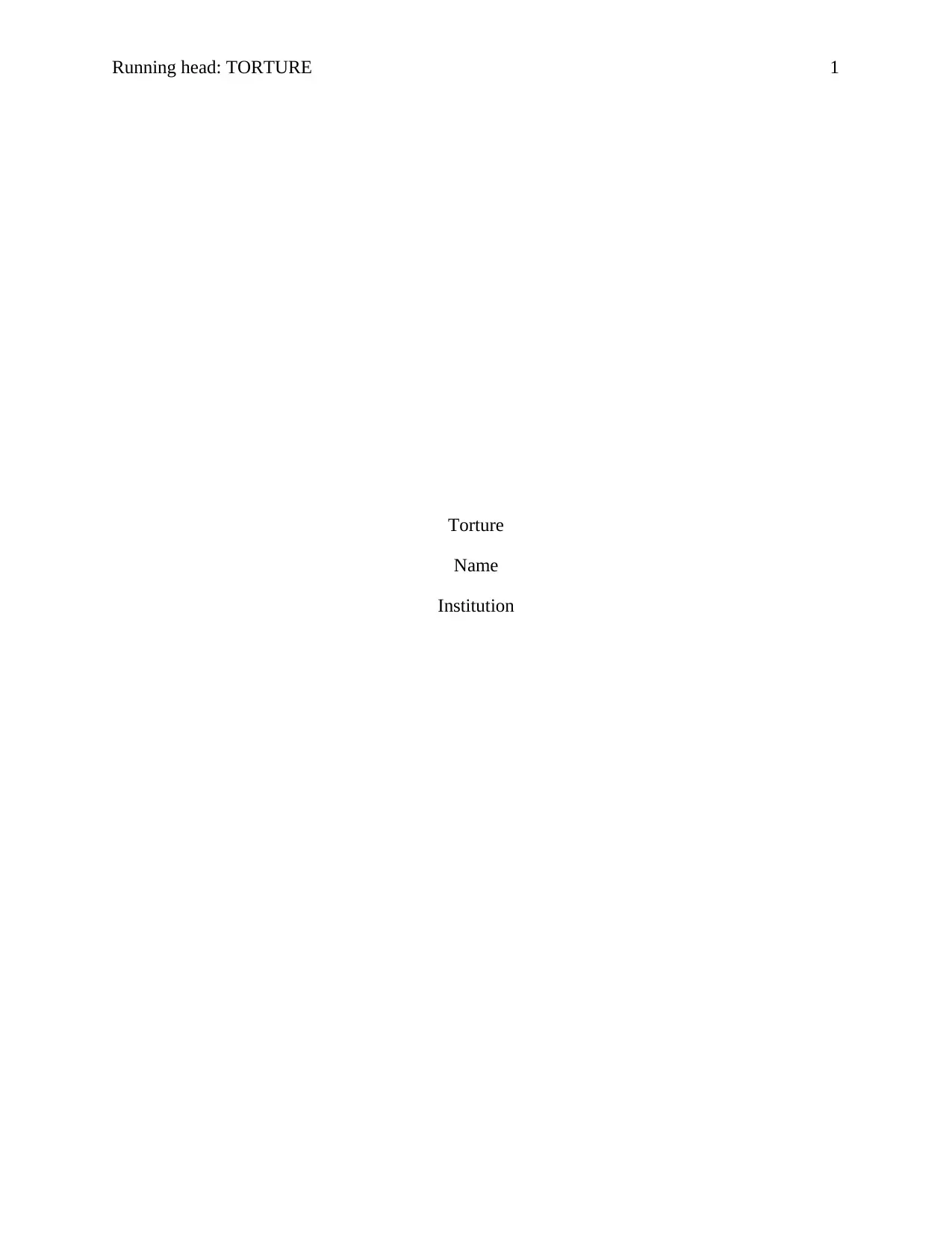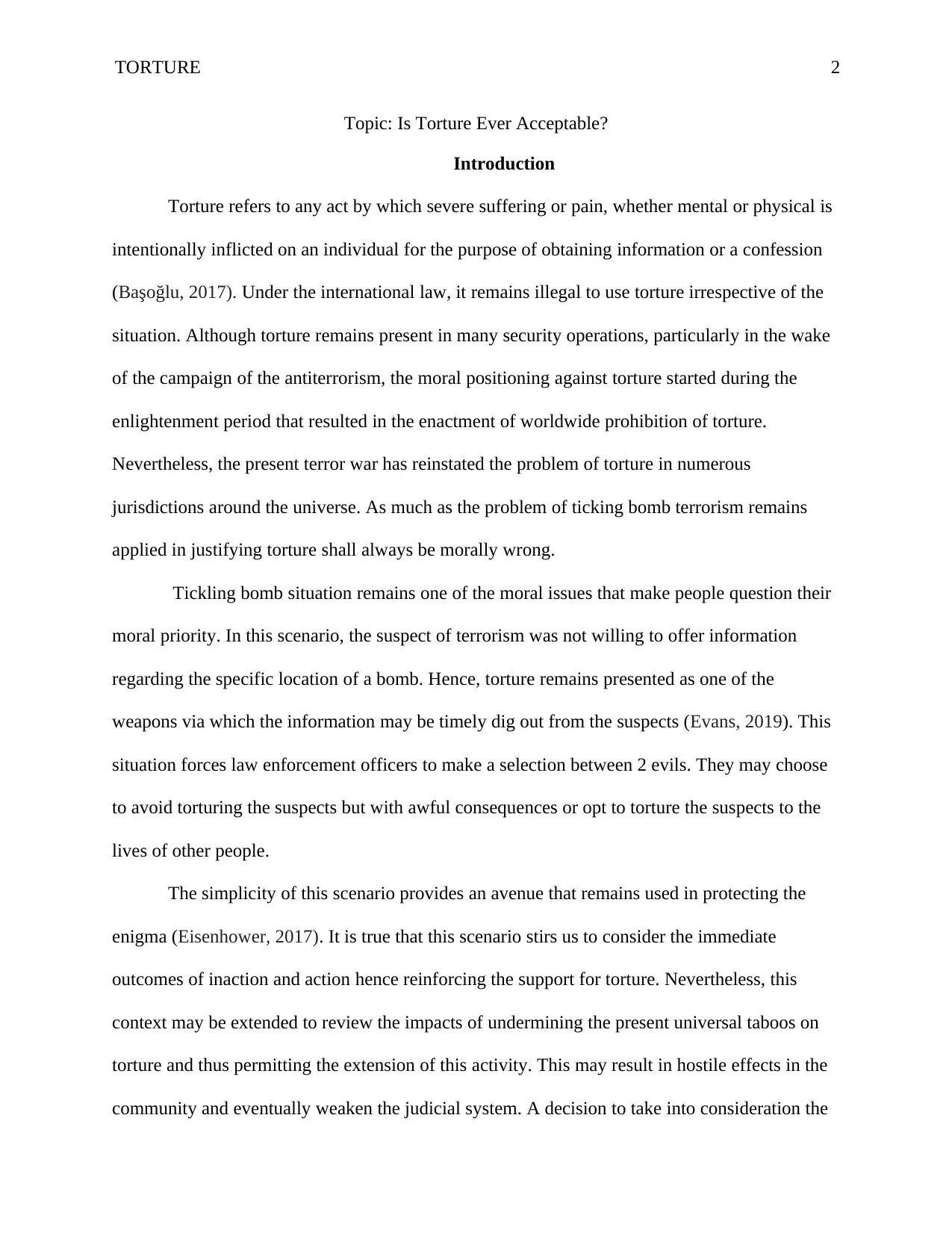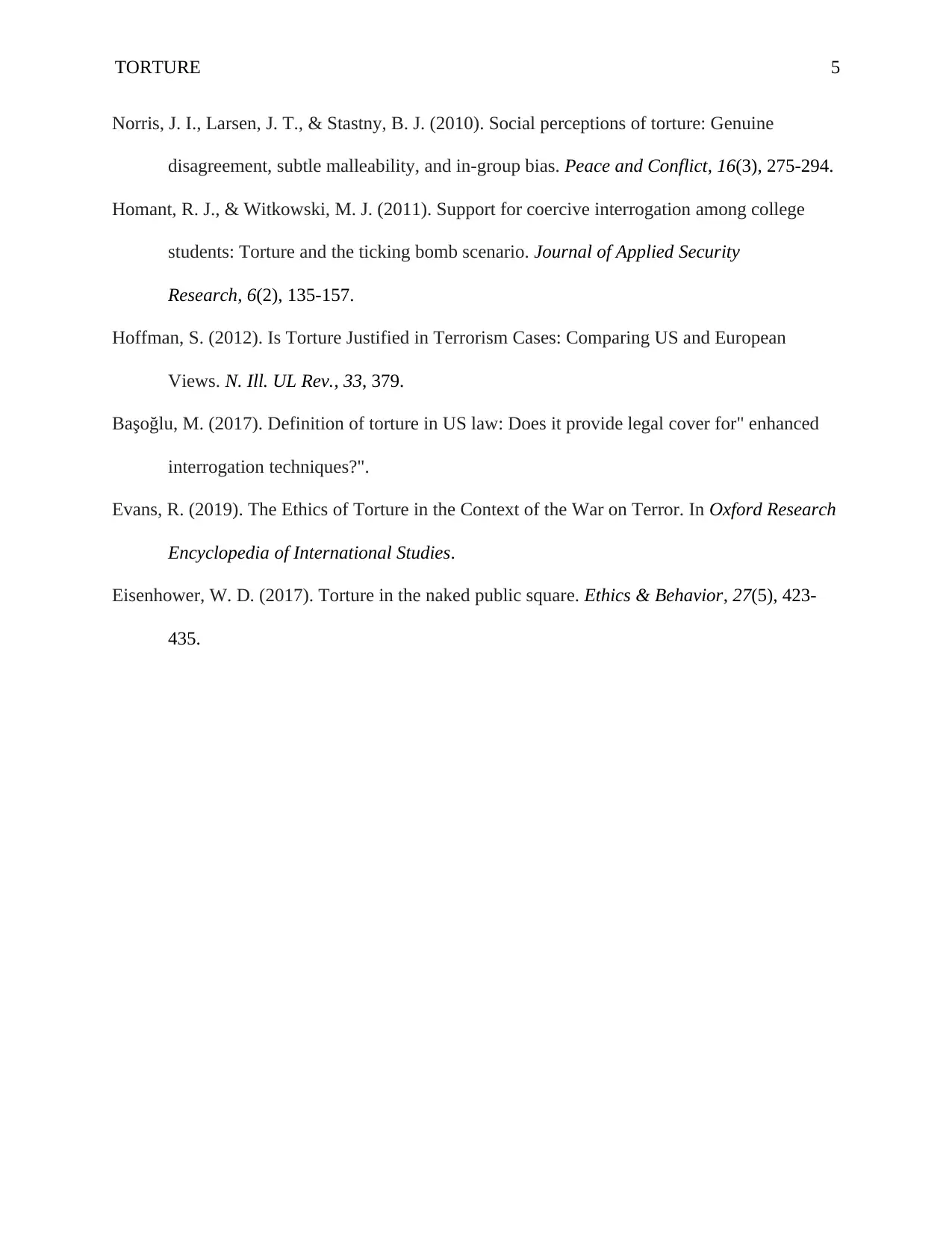Argumentative Essay on Torture: Ethical and Legal Considerations
VerifiedAdded on 2022/09/12
|5
|1011
|20
Essay
AI Summary
This argumentative essay delves into the complex ethical and legal issues surrounding the use of torture. The essay begins by defining torture and acknowledging its illegality under international law, while also recognizing its presence in security operations. The core of the essay centers on the moral dilemma posed by the 'ticking bomb' scenario, where the potential to extract information to save lives is weighed against the inherent wrongness of torture. The essay explores arguments both for and against the use of torture, considering the potential consequences of inaction and the erosion of legal and social norms. It analyzes the views of various researchers, the slippery slope argument, and the impact of the global war on terror on interrogation techniques. The essay concludes that while the ticking bomb scenario may seem to justify torture, the act remains morally wrong due to the multitude of ethical issues it obscures, and the potential for abuse.

Running head: TORTURE 1
Torture
Name
Institution
Torture
Name
Institution
Paraphrase This Document
Need a fresh take? Get an instant paraphrase of this document with our AI Paraphraser

TORTURE 2
Topic: Is Torture Ever Acceptable?
Introduction
Torture refers to any act by which severe suffering or pain, whether mental or physical is
intentionally inflicted on an individual for the purpose of obtaining information or a confession
(Başoğlu, 2017). Under the international law, it remains illegal to use torture irrespective of the
situation. Although torture remains present in many security operations, particularly in the wake
of the campaign of the antiterrorism, the moral positioning against torture started during the
enlightenment period that resulted in the enactment of worldwide prohibition of torture.
Nevertheless, the present terror war has reinstated the problem of torture in numerous
jurisdictions around the universe. As much as the problem of ticking bomb terrorism remains
applied in justifying torture shall always be morally wrong.
Tickling bomb situation remains one of the moral issues that make people question their
moral priority. In this scenario, the suspect of terrorism was not willing to offer information
regarding the specific location of a bomb. Hence, torture remains presented as one of the
weapons via which the information may be timely dig out from the suspects (Evans, 2019). This
situation forces law enforcement officers to make a selection between 2 evils. They may choose
to avoid torturing the suspects but with awful consequences or opt to torture the suspects to the
lives of other people.
The simplicity of this scenario provides an avenue that remains used in protecting the
enigma (Eisenhower, 2017). It is true that this scenario stirs us to consider the immediate
outcomes of inaction and action hence reinforcing the support for torture. Nevertheless, this
context may be extended to review the impacts of undermining the present universal taboos on
torture and thus permitting the extension of this activity. This may result in hostile effects in the
community and eventually weaken the judicial system. A decision to take into consideration the
Topic: Is Torture Ever Acceptable?
Introduction
Torture refers to any act by which severe suffering or pain, whether mental or physical is
intentionally inflicted on an individual for the purpose of obtaining information or a confession
(Başoğlu, 2017). Under the international law, it remains illegal to use torture irrespective of the
situation. Although torture remains present in many security operations, particularly in the wake
of the campaign of the antiterrorism, the moral positioning against torture started during the
enlightenment period that resulted in the enactment of worldwide prohibition of torture.
Nevertheless, the present terror war has reinstated the problem of torture in numerous
jurisdictions around the universe. As much as the problem of ticking bomb terrorism remains
applied in justifying torture shall always be morally wrong.
Tickling bomb situation remains one of the moral issues that make people question their
moral priority. In this scenario, the suspect of terrorism was not willing to offer information
regarding the specific location of a bomb. Hence, torture remains presented as one of the
weapons via which the information may be timely dig out from the suspects (Evans, 2019). This
situation forces law enforcement officers to make a selection between 2 evils. They may choose
to avoid torturing the suspects but with awful consequences or opt to torture the suspects to the
lives of other people.
The simplicity of this scenario provides an avenue that remains used in protecting the
enigma (Eisenhower, 2017). It is true that this scenario stirs us to consider the immediate
outcomes of inaction and action hence reinforcing the support for torture. Nevertheless, this
context may be extended to review the impacts of undermining the present universal taboos on
torture and thus permitting the extension of this activity. This may result in hostile effects in the
community and eventually weaken the judicial system. A decision to take into consideration the

TORTURE 3
scenario of a single ticking bomb makes it easy to ignore the potential results of choice on the
available social and international norms the inhibit torture. It is true that when the convention
against this issue of torture as well as other cruel, inhuman treatment was passed in 1970, all the
member states of the United Nations (UN) supported the idea. Nevertheless, issues relating to the
application of torture started in the 20th century when the universal war on terror remained
declared by the western nations.
Many researchers argue that a decision by democracy to prevent the use of any
approaches to inhibiting terrorist attacks shall result in public outcry. The argument of these
researchers illustrates the increasing occurrence of torture as a technique used for interrogation
on suspects since the incidence of 9/11 (Homant & Witkowski, 2011). For a country to allow as
well as even encourage these levels of disdain for human rights remains significantly
undermining the existing resolutions against torture. If under the present practice of universal
war on terror, the most powerful nations of the world decide to free themselves from the present
universal laws on how prisoners should be handled, the norm may prevail.
Also, slippery slope opinions provide insights on the negative effects of justifying torture.
They remain interested in the gap between practice and theory, where they claim that present
theoretical limits about the use of torture may not work well in practical circumstances.
Even though there are various evidences against torture, it is true that when a person
remains confronted with an instant choice about a ticking bomb issue; she/he is likely to take into
consideration these issues (Hoffman, 2012). Interrogators often use torture because it is alleged
that it is worth the consequences in many cases. Very few people should fail to envisage the
moral foundations of torture more so if it remained performed in an acceptable ticking bomb
scenario. It is true that the complexity of the instant choice between conducting torture and
scenario of a single ticking bomb makes it easy to ignore the potential results of choice on the
available social and international norms the inhibit torture. It is true that when the convention
against this issue of torture as well as other cruel, inhuman treatment was passed in 1970, all the
member states of the United Nations (UN) supported the idea. Nevertheless, issues relating to the
application of torture started in the 20th century when the universal war on terror remained
declared by the western nations.
Many researchers argue that a decision by democracy to prevent the use of any
approaches to inhibiting terrorist attacks shall result in public outcry. The argument of these
researchers illustrates the increasing occurrence of torture as a technique used for interrogation
on suspects since the incidence of 9/11 (Homant & Witkowski, 2011). For a country to allow as
well as even encourage these levels of disdain for human rights remains significantly
undermining the existing resolutions against torture. If under the present practice of universal
war on terror, the most powerful nations of the world decide to free themselves from the present
universal laws on how prisoners should be handled, the norm may prevail.
Also, slippery slope opinions provide insights on the negative effects of justifying torture.
They remain interested in the gap between practice and theory, where they claim that present
theoretical limits about the use of torture may not work well in practical circumstances.
Even though there are various evidences against torture, it is true that when a person
remains confronted with an instant choice about a ticking bomb issue; she/he is likely to take into
consideration these issues (Hoffman, 2012). Interrogators often use torture because it is alleged
that it is worth the consequences in many cases. Very few people should fail to envisage the
moral foundations of torture more so if it remained performed in an acceptable ticking bomb
scenario. It is true that the complexity of the instant choice between conducting torture and
⊘ This is a preview!⊘
Do you want full access?
Subscribe today to unlock all pages.

Trusted by 1+ million students worldwide

TORTURE 4
allowing death makes it challenging to denounce the individual responsible for torture. So, it is
dangerous to approve torture mainly as a tool of extraction of information from the suspects
because of the various consequences of the action on people (Norris, Larsen & Stastny, 2010).
In conclusion, the scenario of the ticking bomb provides the best justification for the use
of torture in modern strategies for controlling terrorism. Nevertheless, from the analysis, torture
is indeed wrong because of the many moral issues it obscures.
References
allowing death makes it challenging to denounce the individual responsible for torture. So, it is
dangerous to approve torture mainly as a tool of extraction of information from the suspects
because of the various consequences of the action on people (Norris, Larsen & Stastny, 2010).
In conclusion, the scenario of the ticking bomb provides the best justification for the use
of torture in modern strategies for controlling terrorism. Nevertheless, from the analysis, torture
is indeed wrong because of the many moral issues it obscures.
References
Paraphrase This Document
Need a fresh take? Get an instant paraphrase of this document with our AI Paraphraser

TORTURE 5
Norris, J. I., Larsen, J. T., & Stastny, B. J. (2010). Social perceptions of torture: Genuine
disagreement, subtle malleability, and in-group bias. Peace and Conflict, 16(3), 275-294.
Homant, R. J., & Witkowski, M. J. (2011). Support for coercive interrogation among college
students: Torture and the ticking bomb scenario. Journal of Applied Security
Research, 6(2), 135-157.
Hoffman, S. (2012). Is Torture Justified in Terrorism Cases: Comparing US and European
Views. N. Ill. UL Rev., 33, 379.
Başoğlu, M. (2017). Definition of torture in US law: Does it provide legal cover for" enhanced
interrogation techniques?".
Evans, R. (2019). The Ethics of Torture in the Context of the War on Terror. In Oxford Research
Encyclopedia of International Studies.
Eisenhower, W. D. (2017). Torture in the naked public square. Ethics & Behavior, 27(5), 423-
435.
Norris, J. I., Larsen, J. T., & Stastny, B. J. (2010). Social perceptions of torture: Genuine
disagreement, subtle malleability, and in-group bias. Peace and Conflict, 16(3), 275-294.
Homant, R. J., & Witkowski, M. J. (2011). Support for coercive interrogation among college
students: Torture and the ticking bomb scenario. Journal of Applied Security
Research, 6(2), 135-157.
Hoffman, S. (2012). Is Torture Justified in Terrorism Cases: Comparing US and European
Views. N. Ill. UL Rev., 33, 379.
Başoğlu, M. (2017). Definition of torture in US law: Does it provide legal cover for" enhanced
interrogation techniques?".
Evans, R. (2019). The Ethics of Torture in the Context of the War on Terror. In Oxford Research
Encyclopedia of International Studies.
Eisenhower, W. D. (2017). Torture in the naked public square. Ethics & Behavior, 27(5), 423-
435.
1 out of 5
Your All-in-One AI-Powered Toolkit for Academic Success.
+13062052269
info@desklib.com
Available 24*7 on WhatsApp / Email
![[object Object]](/_next/static/media/star-bottom.7253800d.svg)
Unlock your academic potential
Copyright © 2020–2025 A2Z Services. All Rights Reserved. Developed and managed by ZUCOL.


